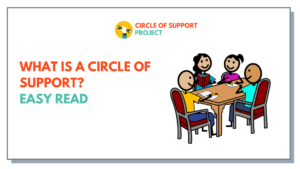The purpose of a circle of support is to help your family member with a disability to build the good life they want. It’s going to be important that your family member is supported to get involved. This isn’t easy if your family member experiences anxiety at meetings, doesn’t read or speak. In the beginning my son Isaac would hide in his room as he was anxious about having lots of people talking about him. He now hovers around and we can see him listening into the conversation. He also expresses his opinions on what we talked about after the meeting using his communication device. It’s been a very slow process but we are getting there. So here are my top tips…..
Tip # 1: Assume their capacity to learn over time what the circle is all about
Assuming capacity is the least dangerous assumption. If we don’t believe our family member can learn then that’s going to lead us to not attempting to help them get involved. And if they are never involved then there may be some missed opportunities to find out what they want for their lives. So check your mindset first and assume they have the capacity to learn over time.
Tip #2: It’s not essential that your family member with a disability attends meetings
Ideally it’s great to have your family member at a meeting and contribute to the conversation. But that’s not so easy if you experience anxiety around lots of people or noise. You can ask them prior to meetings what things they would like to be discussed and let them know what happened afterwards. Over time they may well get the idea and feel more comfortable to join in but it’s not essential. You can still involve them even if they aren’t physically there.
Tip #3: Use visuals to help your family member to participate in the discussion
Prior to the meeting work with one of your circle members or your circle facilitator to create a visual aid that will support discussion of agenda items. It doesn’t have to be made using an expensive software program or printed and laminated – it can be just drawn by hand on a piece of paper.
Here is an easy read document that explains what a circle of support is about….
Tip #4: Start with what’s typical
If you are like me, you can’t just walk up to your family member and ask them what they want in their life. That’s not easy for any of us and if you have difficulty communicating, then that’s going to be even harder.
There’s been lots of research over the years around what makes a good life. Here’s some resources you might like to check out:
Bringing the Good Life to Life – Community Resources Unit
So if your family member has difficulty in communicating what they would like, you can start with what typically makes all people happy then adapt whatever you are doing to the needs of your family member.
Tip #5: Use person centred planning techniques
This will ensure you consider what is important to your family member and not just what you think is important for them. Help your circle members to get to know your family member and what they like and dislike. I always ask circle members “knowing Isaac as you do, what do you think will be important to him?”
Tip #6: Find a role that your family member enjoys and the other circle members appreciate at circle meetings
Isaac is the host with the most. He greets people at the door and opens the door for them when they leave. We are working on other roles – handing out afternoon tea, handing out any notes for people and so on. Think about what kind of role your family member might enjoy at your circle meetings that the members will value.
Get step by step guidance on starting and running a circle of support in my Circle of Support Project
This project will help you to lower your anxiety over asking for help from family and friends, figure out who to ask, how to ask, what you are asking for, how to run your first and subsequent circle gatherings and how to maintain communication and momentum in between gatherings.
I’ll also help you to figure out how to involve your family member with a disability in gatherings and decision making even if they struggle with anxiety or communication.




